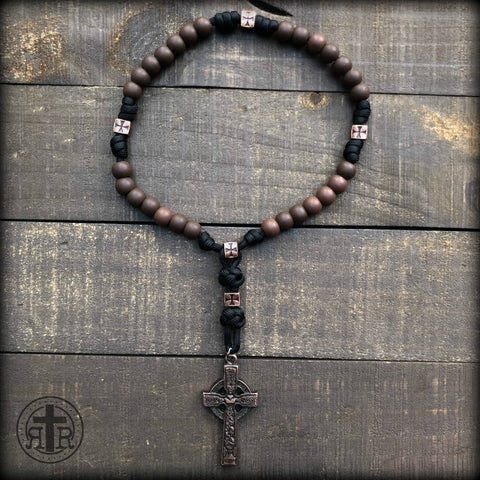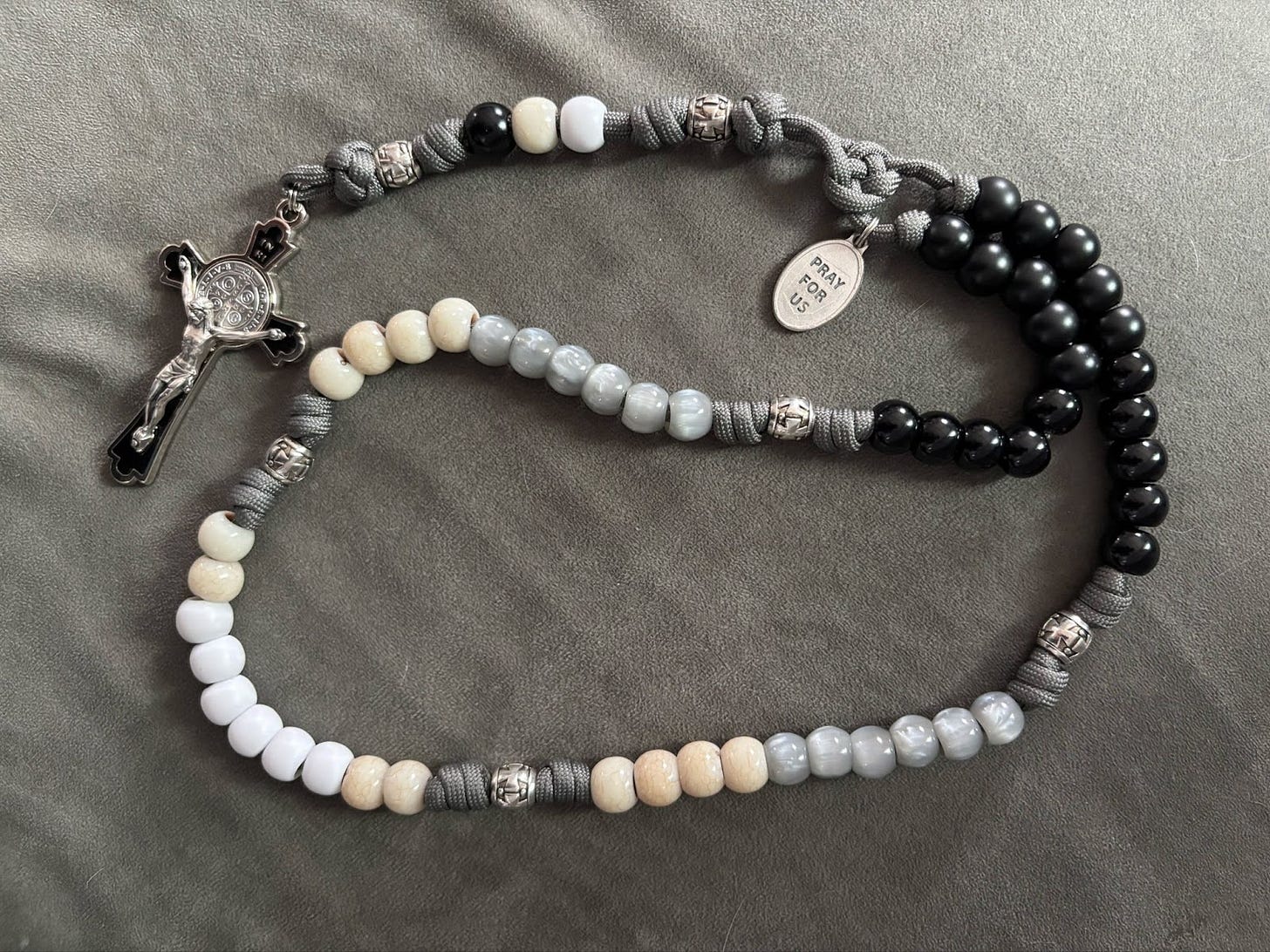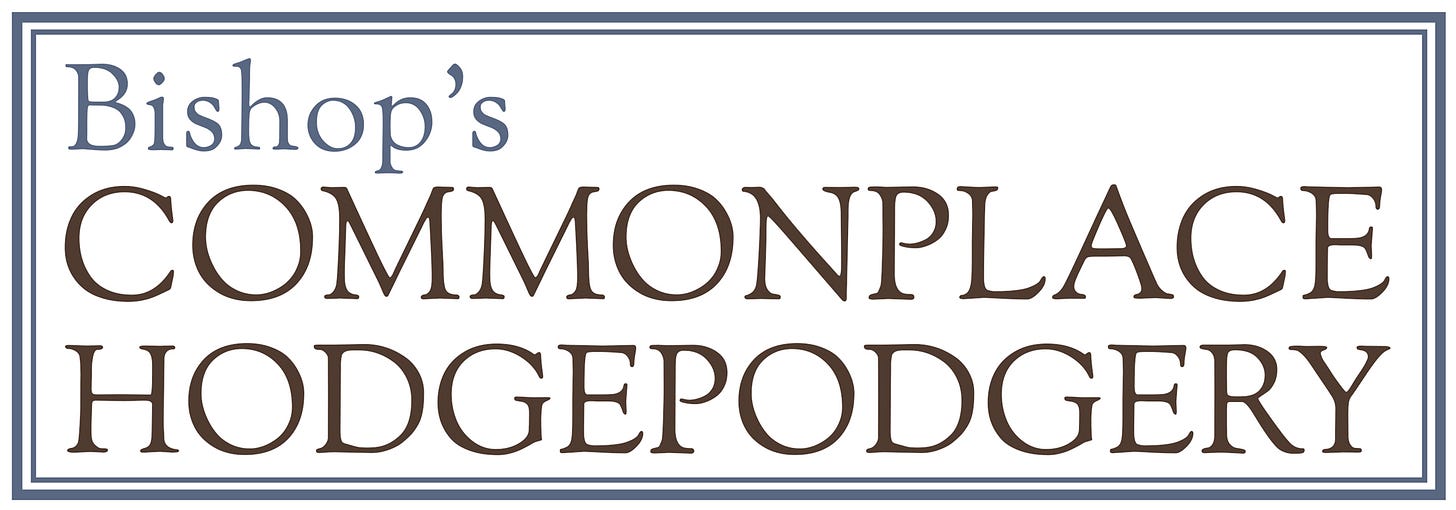In 2019, one of my Catholic friends loaned me a rosary and told me to just, “Try it out, and see what you think.” So I did.
I took it to a local park, found a secluded picnic table in the shade, and started praying as I counted the beads through my fingers. To be clear, I don’t think I used it as my friend intended me to use it, which is to say that I didn’t Hail Mary (more about this below). But I did use it to count my prayers, and I found that I liked it. I used it at home later that week. And then I used it again.
After a couple of weeks, I returned his rosary with gratitude and promptly ordered a handsome Anglican rosary from Rugged Rosaries. I’ve been praying with it ever since. Here’s what it looks like:
Why I use a rosary to pray
The main reason I use a rosary is that it helps me to focus. Having something tactile and physical to use while I pray keeps my mind from wandering to other things and helps me maintain a sustained time of personal prayer with much less distraction. If I do start to chase my thoughts away from my prayers, I feel the beads in my hand, move my fingers to the next one, and refocus again.
I’ve also found that the meditative repetition of a single prayer over and over is both calming and spiritually formative. It is good to pray the Jesus Prayer once (“Lord Jesus Christ, Son of God, have mercy on me, a sinner”), and it is also good to pray it 28 times (or 50 times on the Catholic rosary) while meditating on the depths of my sin and the mercy of the Lord Jesus Christ.
Finally, I find the Anglican rosary to be in line with the sort of earthy spirituality and sacramentalism that I’ve come to value about Anglican Christianity. Prayer is primarily through words, yes, but I’ve also learned to appreciate prayers that incorporate my body, too, whether by making the sign of the cross, kneeling, or moving beads through my fingers. It’s a holistic, embodied spiritual practice, rather than a strictly mental one.
Okay, but why an Anglican rosary?
By this, I mean why use an Anglican rosary as opposed to a Catholic rosary or an Orthodox prayer rope (or chotki). And the first and primary answer is that I’m a Protestant, not Catholic or Orthodox.
I have a couple of Orthodox friends, and there’s a lot that I admire about their faith — but I’ve never seriously considered Orthodoxy for myself, mostly because I’m a thoroughgoing son of the West. So peculiarly Orthodox practices (like a prayer rope instead of a rosary) seem inherently foreign to me. If Protestant to Catholic is a big step, then West to East is an even bigger step, and one I’m frankly not interested in taking.
Neither am I interested in taking the Protestant-to-Catholic step, though. I have several Roman friends, and there’s a lot that I admire about their faith, too (boy howdy, is there ever!), but the Catholic rosary is a peculiarly Marian practice, and I disagree with most Marian dogma and with what I consider to be the excesses of Marian devotion. So while I have a stunningly beautiful Catholic rosary (also from Rugged Rosaries, and pictured below) that I do use from time to time, I use it in a decidedly non-Marian fashion. (Basically, I use it in the same way that I use my Anglican rosary, only with more beads.)
All of this — that the Anglican rosary is not Catholic or Orthodox — brings us to one of the demerits of the Anglican rosary, which is that it admittedly hasn’t been around for very long. It simply doesn’t have the same historical pedigree as a Catholic rosary or Orthodox prayer rope. I believe it originates from the 1980s, and, so far as I can tell, most Anglicans I know don’t use one (full disclosure: I’m not Anglican, but that’s a different story).
Another demerit, related to the first, is that there’s something about it that feels — and perhaps is — foreign or derivative or a la carte, as if, in typically Protestant fashion, those of us who use it are simply picking and choosing from among a menu of liturgical or devotional practices that are otherwise foreign to (parts of) Protestantism.
I think there’s something to these criticisms; I don’t disagree. But I also don’t think it’s reason enough to not use it. Besides, the fact that using prayer beads (or knots or stones) is part of both Catholic and Orthodox practices means that it does have a longstanding Christian pedigree. Is it historically Protestant, or even uniquely Anglican? No. But it is historically Christian. If it’s a helpful practice, and if it’s a recognizable part of Christian tradition, then count me in.
Explaining the Anglican rosary
Alright, now to the specifics of the Anglican rosary.
An Anglican rosary has a total of 33 beads plus a cross or crucifix. As you can see from the first picture above, the cross is at the bottom; directly above this is a single bead, called an “invitatory bead.” The rest of the beads form a perfect circle, and they’re split into four groups of seven simple beads. Each group of seven is called a “week” (similar to the Catholic “decade” of 10 beads). Between each week are four beads called “cruciform” beads, so named because when the rosary is laid out in a circle they take a cruciform shape.
When praying, you start at the cross, work your way up to the invitatory bead, then go all the way around the circle a bead at a time, and finally drop back down to the invitatory bead, and finish where you started on the cross.
There’s a lot of symbolism built into the Anglican rosary. Here are some of them:
There are 33 beads, one for each year of the life of Jesus Christ
The cruciform beads make a cruciform shape, which is further elongated by the invitatory bead and cross
The cruciform beads also form the shape of a compass rose, encompassing the whole world
The Anglican rosary reflects how we order time: There are seven days in a week, and four weeks in a month; there are also four seasons in a year
The 28 beads in the four weeks roughly reflect the lunar cycle
There are four weeks, and four cruciform beads, just as there are four gospels
How I use the Anglican rosary
I don’t intend for this section to be prescriptive but descriptive – one benefit of the lack of tradition built into the Anglican rosary is that it’s open to many different ways of using it. The three below are how I most often structure my prayers.
Meditative prayers
I use the word “meditative” to refer to short prayers repeated many times. This is the primary way I pray the Anglican rosary. Here’s what it looks like:
Cross: Holding the rosary’s cross, I cross myself with it and recite a prayer. This is almost always the Glory Be (“Glory be to the Father and to the Son and to the Holy Ghost. As it was in the beginning, is now, and ever shall be, world without end. Amen.”).
Invitatory: This is usually the Apostles’ Creed, but I sometimes recite the Lord’s Prayer (Our Father) if I’ve decided to use something else on the cruciform beads.
Cruciform: I usually pray the Lord’s Prayer on each of these beads (it’s the same for each of the four beads), but another favorite is the Trisagion (“Holy God, Holy Mighty, Holy Immortal, have mercy on us.”).
Weeks: On each of the beads in the four weeks, I pray a short, simple prayer, like one of the following. I usually pray the same prayer for all 28 beads (with the cruciform beads after every week), but you may want to switch up a different prayer for each of the four weeks.
Jesus Prayer – “Lord Jesus Christ, Son of God, have mercy on me, a sinner”
Julian of Norwich’s prayer –“All shall be well, and all shall be well, and all manner of things shall be well.”
Revelation 4:8 – “Holy, holy, holy, is the Lord God Almighty, who was and is and is to come!”
Kyrie eleison – “Lord, have mercy. Christ, have mercy. Lord, have mercy.”
“Oh God, make speed to save us. Oh Lord, make haste to help us.”
Invitatory: On the way “out” I recite the same invitatory prayer that I used on the way in (Apostles’ Creed or the Lord’s Prayer) or recite something like, “Let us bless the Lord. Thanks be to God.”
Cross: I typically finish by holding the cross and reciting Galatians 2:20 (“I have been crucified with Christ. It is no longer I who live, but Christ who lives in me. And the life I now live in the flesh I live by faith in the Son of God, who loved me and gave himself for me”) or a scriptural benediction.
Personal prayers
This follows the same general pattern as the meditative prayers above, but instead of repeating the same prayer for all four weeks, I dedicate each week to praying for a particular person or thing. Each bead is used for a different intention; for example, if I’m praying for my wife, I might pray for her physical healing on one bead, her sanctification and growth in Christ on the second, etc.
Here are some of the things I pray for in this way:
My wife
My children
Our marriage
Our family as a whole
A friend or a group of friends
Our church
My employer
Our neighborhood
Our city
Our nation
Our political leaders
The poor or needy
As a sleep aid
Finally, I almost always fall asleep with my rosary in my hands. I’ve found that nothing stills and quiets my mind and spirit like praying myself to sleep — especially when I’m stressed or worried or preoccupied. I begin the meditative prayers as above, and — Bam! — I’m out before I get three or four beads in. It used to bother me that I fell asleep while praying, but I really can’t think of a better way to drift off. It’s become one of the most precious parts of my night.
And check out my other Substack publications, Bishop’s Commonplace Hodgepodgery and Christ Is Lord.










Great stuff! Really interesting perspective. I’ve always found Anglicanism super interesting.
Recently wrote a post dealing with questions of God and morality. If it is of interest.
https://dbtaylor.substack.com/p/a-discussion-with-ai-friedrich-nietzsche?r=22o631&utm_medium=ios